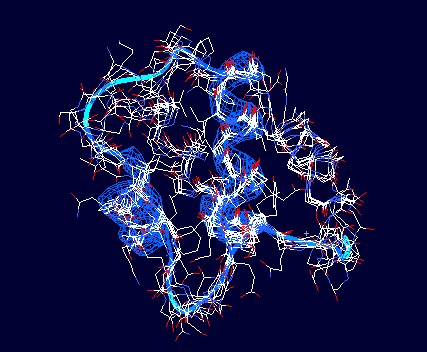
The objective of this project is to study the vitamin D-binding protein, which is a member of the serum albumin family. This family includes four members that are known to be evolutionary related: albumin, alpha-fetoprotein, vitamin D-binding protein (Cooke et al. 1985) and afamin (Belanger et al. 1994).

The four members of the family share a similar structure. They contain three homologous domains that have descended of an evolutionary ancestor, which arose itself by an intragenic triplication (Brown, 1976). Each domain is defined by the invariant position of cysteine residues that are cross-linked by disulphide bonds.
All four genes are mapped
in a multigene cluster is the chromosome 4, in the region 4q11-q13 (Song
et al. 1999).
Figure
1. VTDB 3D structure (Swiss-Model)
These proteins play an important role as carriers, although they have acquired more specialised functions:
Albumin (ALB)
is a soluble, monomeric protein which comprises about one-half of
the blood serum protein. It binds water, cations (such as Ca2+, Na+ and
K+), fatty acids, hormones, bilirubin and drugs. Its main function is to
regulate the colloidal osmotic pressure of blood.
Mutations in the ALB gene on chromosome
4 result in various anomalous proteins.
Vitamin D-binding
protein (VTDB), alternatively known as Gc-globulin, is a multifunctional
protein found in plasma, ascitic fluid, cerebrospinal fluid and urine.
It associates with membrane-bound immunoglobulin on the surface of B-lymphocytes
and with IgG-Fc receptor on the membranes of T-lymphocytes. This protein
interacts with any form of the fat-soluble vitamin D or protein whose transcription
is regulated by the biologically active form of vitamin D, i.e.1,25-dihydroxy
vitamin D3 (calcitriol). UV irradiation is necessary for the activation
of calcitriol. Deficiency in vitamin D leads to the disease rickets, in
children, and osteomalacia, in adults.
VTDB also prevents polymerisation of actin
by binding its monomers.
There have been identified over 120 variants
of the vitamin D-binding protein gene (GC). The three most common alleles
are called GC1F, GC1S and GC2 (Kofler et al. 1995).
The rat VTDB gene is expressed at high
levels in liver and at moderate levels in kidney, testis, abdominal fat
and yolk sac (Cooke et al. 1991).
Alpha-fetoprotein (AFP) is a fetal plasma protein that also binds various cations, fatty acids and bilirrubin.
Afamin (AFM)
has a possible role in the transport of some yet unknown ligand.It's also
called alpha-albumin.
Home | Introduction | Gene analysis | Protein analysis | Evolutionary study | References